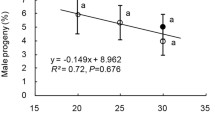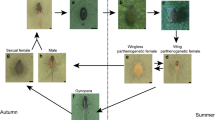Abstract
A Japanese strain of Frankliniella fusca (Hinds) was reared under 4 temperature and two photoperiodic conditions on leaves of green bean. On the basis of the ratio of fore wing length to head width (RWL) of adult thrips we defined individuals with RWL above 3.7 as macropterous forms and those with RWL below 3.5 as brachypterous forms. Percentages of macropterous individuals among females were 0 % at 18 °C, 10.6 % at 22.5 °C, 21.8 % at 25 °C, and 77.5 % at 27.5 °C, under 15L–9D. The proportion of macropters among females developing under 15L–9D was no different from that among those developing under 10L–14D. These results indicate that photoperiod does not affect wing form, and suggest that the proportion of macropterous females increases with temperature. Although development time from hatching to adult eclosion, adult pre-oviposition period, adult head width, adult longevity, total fecundity, and fecundity schedule were compared between macropterous and brachypterous females developing at 25 °C and 15L–9D, these traits were not significantly different between the wing forms. Males of this experimental strain were all brachypterous.




Similar content being viewed by others
References
Barbour JD, Brandenburg RL (1994) Vernal infusion of thrips into North Carolina peanut fields. J Econ Entomol 87:446–451
Chamberlin JR, Todd JW, Beshear RJ, Culbreath AK, Demski JW (1992) Overwintering hosts and wingform of thrips, Frankliniella spp., in Georgia (Thysanoptera: Thripidae): implications for management of spotted wilt disease. Environ Entomol 21:121–128
Chamberlin JR, Culbreath AK, Todd JW, Demski JW (1993a) Detection of tomato spotted wilt virus in tobacco thrips (Thysanoptera: Thripidae) overwintering in harvested peanut fields. J Econ Entomol 86:40–45
Chamberlin JR, Todd JW, Culbreath AK, Johnson WC, Demski JW (1993b) Post-harvest management of tobacco thrips (Thysanoptera: Thripidae) overwintering in peanut fields. J Entomol Sci 28:433–446
Eddy CO, Livingstone EM (1931) Frankliniella fusca Hinds (thrips) on seeding cotton. South Carolina Agricultural Experimental Station Bulletin 271:1–23
Groves RL, Walgenbach JF, Moyer JW, Kennedy GG (2001) Overwintering of Frankliniella fusca (Thysanoptera: Thripidae) on winter annual weeds infected with tomato spotted wilt virus and patterns of virus movement between susceptible weed hosts. Phytopathology 91:891–899
Groves RL, Walgenbach JF, Moyer JW, Kennedy GG (2003) Seasonal dispersal patterns of Frankliniella fusca (Thysanoptera: Thripidae) and tomato spotted wilt virus occurrence in central and eastern North Carolina. J Econ Entomol 96:1–11
Higgins CJ, Myers JH (1992) Sex ratio patterns and population dynamics of western flower thrips (Thysanoptera: Thripidae). Environ Entomol 21:322–330
Kahn ND, Walgenbanch JF, Moyer JW, Kennedy GG (2005) Summer weeds as hosts for Frankliniella occidentalis and Frankliniella fusca (Thysanoptera: Thripidae) and as reservoirs for tomato spotted wilt virus in North Carolina. J Econ Entomol 98:1810–1815
Kamm JA (1972) Environmental influence on reproduction, diapause, and morph determination of Anaphothrips obscurus (Thysanoptera: Thripidae). Environ Entomol 1:16–19
Köppä P (1970) Studies on the thrips (Thysanoptera) species most commonly occurring on cereals in Finland. Ann Agric Fenn 9:191–265
Kudo I (1988) Methods of collecting thrips. In: Umeya K, Kudo I, Miyazaki M (eds) Pest thrips in Japan. Zenkoku Noson Kyoiku Kyokai Publishing, Tokyo, pp 353–356 (In Japanese)
Lewis T (1997) Major crops infested by thrips with main symptoms and predominant injurious species. In: Lewis T (ed) Thrips as Crop Pests. CAB International, Wallingford, pp 675–709
McPherson RM, Pappu HR, Jones DC (1999) Occurrence of five thrips species on flue-cured tobacco and impact on spotted wilt disease incidence in Georgia. Plant Dis 83:765–767
Morsello SC, Kennedy GG (2009) Spring temperature and precipitation affect tobacco thrips, Frankliniella fusca, population growth and tomato spotted wilt virus spread within patches of the winter annual weed Stellaria media. Entomol Exp Appl 130:138–148
Morsello SC, Groves RL, Nault BA, Kennedy GG (2008) Temperature and precipitation affect seasonal patterns of dispersing tobacco thrips, Frankliniella fusca, and onion thrips, Thrips tabaci (Thysanoptera: Thripidae) caught on sticky traps. Environ Entomol 37:79–86
Morsello SC, Beaudoin ALP, Groves RL, Nault BA, Kennedy GG (2010) The influence of temperature and precipitation on spring dispersal of Frankliniella fusca changes as the season progresses. Entomol Exp Appl 134:260–271
Mound LA (2005a) Thysanoptera: diversity and interactions. Annu Rev Entomol 50:247–269
Mound LA (2005b) Fighting, flight and fecundity: behavioural determinants of Thysanoptera structural diversity. In: Ananthakrishnan TN, Whitman D (eds) Insect phenotypic plasticity: diversity of responses. Science Publishers Inc, Enfield, pp 81–105
Mound LA, Marullo R (1996) The Thrips of Central and South America: an introduction (Insecta: Thysanoptera). Mem Entomol International Associated Publishers, Florida, vol 6, p 487
Murai T, Loomans AJM (2001) Evaluation of an improved method for mass-rearing of thrips and a thrips parasitoid. Entomol Exp Appl 101:281–289
Nakao S (1993) Effects of temperature and photoperiod on wing form determination and reproduction of Thrips nigropilosus Uzel (Thysanoptera: Thripidae). Appl Entomol Zool 28:463–472
Nakao S (1994a) Effects of food type on wing form determination and development in female Thrips nigropilosus Uzel (Thysanoptera: Thripidae). Appl Entomol Zool 29:273–278
Nakao S (1994b) Wing polymorphism in females of arrhenotokous Thrips nigropilosus: relationship between wing form and life history traits in two geographical strains with different genetic components of brachyptery. Proceedings of memorial and international symposium on dispersal polymorphism of insects, its adaptation and evolution, Okayama University, Japan, pp 153–161
Nakao S (1995) Effect of high-density rearing on the incidence of brachypterae in female Thrips nigropilosus Uzel (Thysanoptera: Thripidae). Appl Entomol Zool 30:249–251
Nakao S (1997) Overwintering and seasonal changes in wing form composition of Thrips nigropilosus Uzel (Thysanoptera: Thripidae) in Kyoto, Japan. Appl Entomol Zool 32:49–55
Nakao S (1999) Brachypterism in thelytokous Thrips nigropilosus (Thysanoptera: Thripidae) at high density and its adaptive significance. Entomol Sci 2:189–194
Nakao S (2011) Geographical variation of photoperiodic wing form determination and genetic background of reproductive diapause in arrhenotokous populations of Thrips nigropilosus Uzel (Thysanoptera: Thripidae) in Japan. Appl Entomol Zool 46:111–116
Nakao S, Chikamori C, Okajima S, Narai Y, Murai T (2011) A new record of the tobacco thrips Frankliniella fusca (Hinds) (Thysanoptera: Thripidae) from Japan. Appl Entomol Zool 46:131–134
Roff DA (1990) The evolution of flightlessness in insects. Ecol Monogr 60:389–421
Roff DA, Fairbairn DJ (1991) Wing dimorphisms and the evolution of migratory polymorphisms among the insecta. Amer Zool 31:243–251
Sakimura K (1963) Frankliniella fusca, an additional vector for the tomato spotted wilt virus; with notes on Thrips tabaci, another vector. Phytopathology 53:412–415
Stannard LJ (1968) The thrips, or Thysanoptera, of Illinois. Bull Illinois Nat Hist Survey 29:309–312
Trichilo PJ, Leigh TF (1988) Influence of resource quality on the reproductive fitness of flower thrips (Thysanoptera: Thripidae). Ann Entomol Soc Am 81:64–70
Wells ML, Culbreath AK, Todd JW, Csinos AS, Mandal B, McPherson RM (2002) Dynamics of spring tobacco thrips (Thysanoptera: Thripidae) populations: implications for tomato spotted wilt virus management. Environ Entomol 31:1282–1290
Acknowledgments
We wish to thank Mr Y. Narai (Shimane Agricultural Technology Center, Shimane Prefecture) for providing the thrips strain.
Author information
Authors and Affiliations
Corresponding author
Rights and permissions
About this article
Cite this article
Nakao, S., Chikamori, C. Temperature-dependent wing dimorphism in a Japanese strain of tobacco thrips, Frankliniella fusca (Thysanoptera: Thripidae). Appl Entomol Zool 48, 337–343 (2013). https://doi.org/10.1007/s13355-013-0193-3
Received:
Accepted:
Published:
Issue Date:
DOI: https://doi.org/10.1007/s13355-013-0193-3




